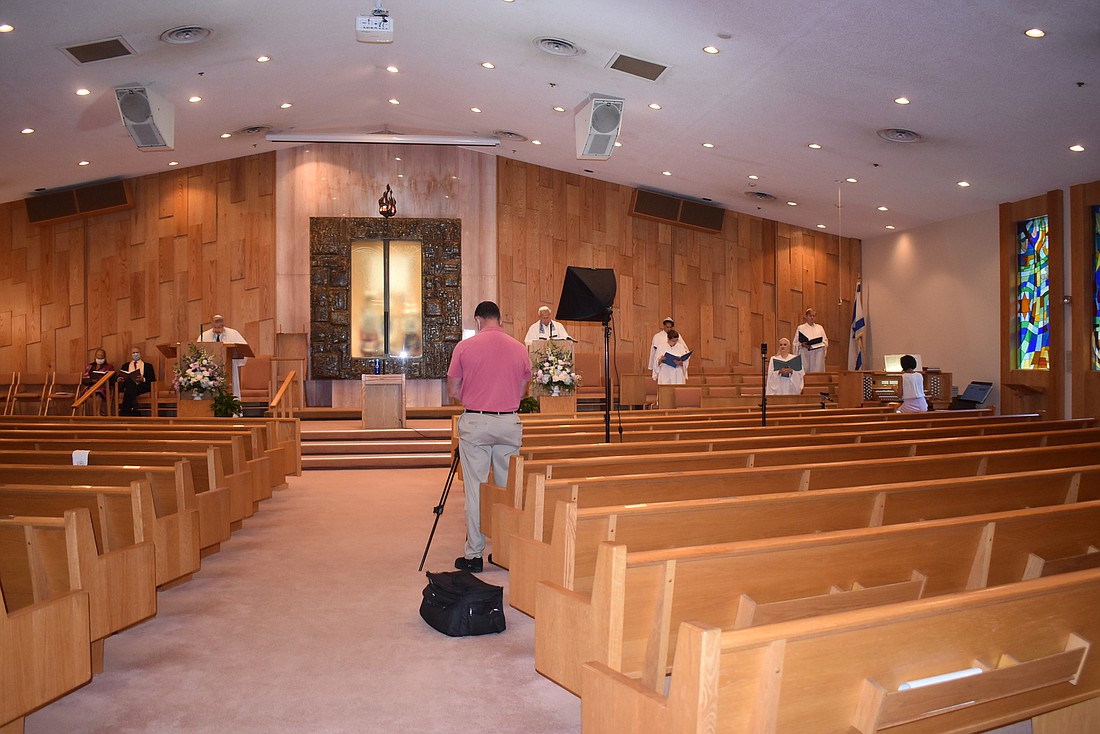- November 24, 2024
-
-
Loading

Loading

On Aug. 21, Rabbi Stephen Sniderman stood in the sanctuary of Temple Beth Israel and gave his High Holy Days service.
But the congregation wasn’t there, and the High Holy Days of Rosh Hashanah and Yom Kippur are not until Sept. 19 and 28, respectively. Instead, Rabbi Sniderman spoke to a gathered few including temple President Stuart Sinai and his wife Carole Shaw, and executive director Isaac Azerad. A professional choir sat several seats apart from each other as a video team kept tabs on two cameras running to capture the service, which was recorded over three days. For the 2020 High Holy Days, Temple Beth Israel is going virtual.
“We do this every week anyway, without all the fancy stuff,” said Sniderman, who comes in weekly to record services for the congregation as they stay home amid the coronavirus pandemic. “It’s going much better than I feared. It’s something we’ve never had to do before.”
After months of video gatherings instead of in-person, the temple is not yet in the throes of Zoom fatigue. Instead, they’re leaning into virtual offerings, especially now. Their video equipment has been upgraded and Azerad also hired a producer to work some movie magic and put all the elements of the High Holy Days services together once they’re recorded.
For example, the congregational choir recorded their parts separately (some scattered all over the country), but once the video is done the professional choir and the congregants will be blended together so it looks like everyone is sitting in their normal seats. Traditional elements like the shofar, a ram’s horn trumpet, will also be blended in.
“These are temple members who are permanent parts of the choir, but when they are out of town they couldn’t participate in the past,” Azerad said. “The advantage of this virtual world we’re living in is that they can, so that’s kind of interesting. The disadvantage is the human factor. You don’t hug or touch. [But] I guess we’re learning skills that will help us even beyond the pandemic at some point.”
Given the importance of the holidays in the calendar of the Jewish faith, of course everyone would prefer to be together. Rosh Hashanah is the Jewish New Year and it’s often like a reunion, Sniderman said, where everyone gets together, shares a meal for Rosh Hashanah and breaks the fast of Yom Kippur.
“The sense of community isn’t there quite as strongly,” Sniderman said.
However, even as other parts of the world open up around them, the idea of having the High Holy Days virtually was never a question, Azerad said, and the temple is in no rush to reopen. From the beginning they have taken a “maximalist” view of safety, Azerad said, and are staying the course for the good of their congregation.
“Consequently, yes, there's always the tendency or the regret that we're not together, but we all understand that it's for the benefit of the collective,” Azerad said. “We can't have the possibility of endangering anyone for the benefit of having a better time.”
Apart though they’ll be, there are a myriad ways the congregation will be able to feel like they’re together.
Since members would normally follow services through the prayer books in the temple, Azerad and the temple team designed a 2020 High Holy Days booklet that was sent out to members. It includes not only the prayers, but also the whole schedule, members’ recipes for the traditional apple cake and breaking the fast and messages from temple leadership and members.
“We're basically re-creating all the elements of a family membership, with the exception of the fact that we're not physically next to each other,” Azerad said. “You can provide a lot of cultural and artistic and educational programs and they have their value. But the important part is getting together in some fashion, whether it's virtual or physical. It’s extremely important for the morale and solidarity of the extended family.”